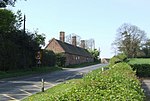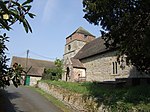Buildwas Formation
Deep marine depositsFossiliferous stratigraphic units in WalesGeologic formations of EnglandLimestone formationsMuch Wenlock ... and 6 more
Mudstone formationsPaleontology in EnglandSheinwoodianSilurian EnglandSilurian System of EuropeSilurian southern paleotropical deposits

The Buildwas Formation (Bw, BUI), formerly called Wenlock Shale and Buildwas Beds, is a geologic formation in Shropshire, England. It preserves fossils dating back to the Silurian period. The formation is the defining formation of the Sheinwoodian age of the Wenlock epoch, the Middle Silurian.
Excerpt from the Wikipedia article Buildwas Formation (License: CC BY-SA 3.0, Authors, Images).Buildwas Formation
B4376,
Geographical coordinates (GPS) Address Nearby Places Show on map
Geographical coordinates (GPS)
| Latitude | Longitude |
|---|---|
| N 52.6 ° | E -2.5 ° |
Address
B4376
TF12 5BW
England, United Kingdom
Open on Google Maps










